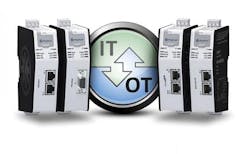Anybus .NET Bridges for PROFIBUS, PROFINET, EtherCAT and EtherNet/IP bridge the gap between Operational Technology (OT) and IT. The .NET bridge family enables data from industrial machinery to be presented to .NET-based IT applications. The result is that .NET programmers can build a PC program which exchanges live data with a PLC system — for statistics, analysis or maintenance.
The basic prerequisite for Industrial IoT is that IT systems get access to data from industrial applications. However, the fieldbus and industrial Ethernet networks of the factory floor are designed for real-time communication - by default separated from the IT-infrastructure. The Anybus .NET Bridges address this situation by acting as translators between OT and IT — sending and receiving data between the factory networks and IT platforms using .NET as a framework.
The communication is set up in a couple of minutes and the .NET Bridges are therefore a very fast way to realize IIoT.
Thanks to the data bridging capabilities of the Anybus .NET Bridges, IT systems get unprecedented access to real-time data from the factory floor which enables predictive maintenance, KPI-follow-up, machine analytics, data mining, big data processing, production statistics and much more - without interfering with the industrial processes.
The solution can be used for a wide range of use cases, from simple transfer of KPI values, advanced messages with structured data types, or ultra-fast transfer of I/O data for big data.
The information exchange between the OT and IT is defined in a spreadsheet template which defines how the data is mapped, tagged and presented to IT-applications. The spreadsheet is uploaded to the HMS code generator which automatically creates a customized high- level C# API (events and Post methods) that is easy to integrate directly into a .NET application. It also generates a customized GSDML or XML file for the PLC.
Features:
- Creates a bridge between the logic in a PLC and a .NET solution in a PC
- Synchronized communication with handshake
- Two-way communication
- Very easy to configure and provides easy to use simulator tools
- Data configuration is isolated to one single spreadsheet
- Minimal or no hardware configuration - easy to replace
- Possible to transfer very large amounts of data
- DIN-rail or wall mount options
- Up to 65535 different unique defined message types
- Every defined message type size up to 251 bytes





